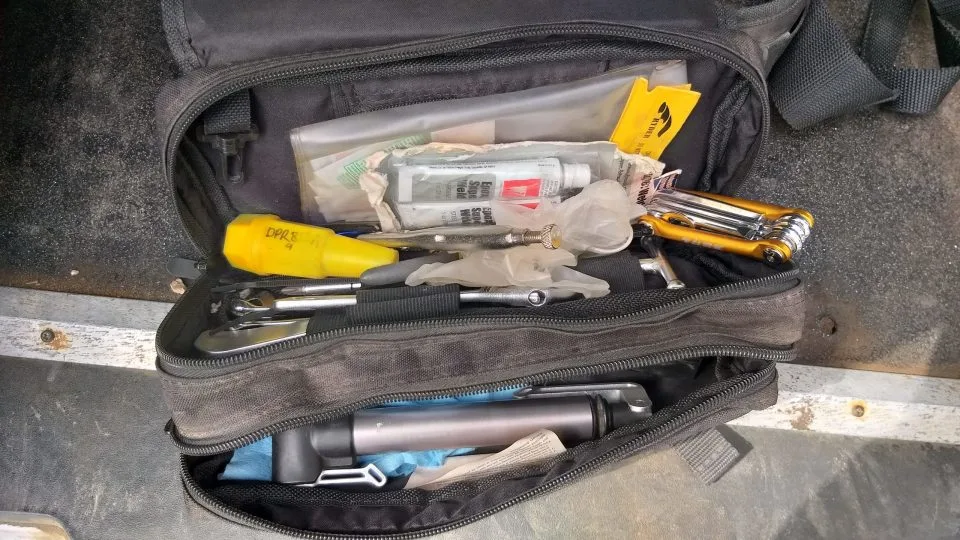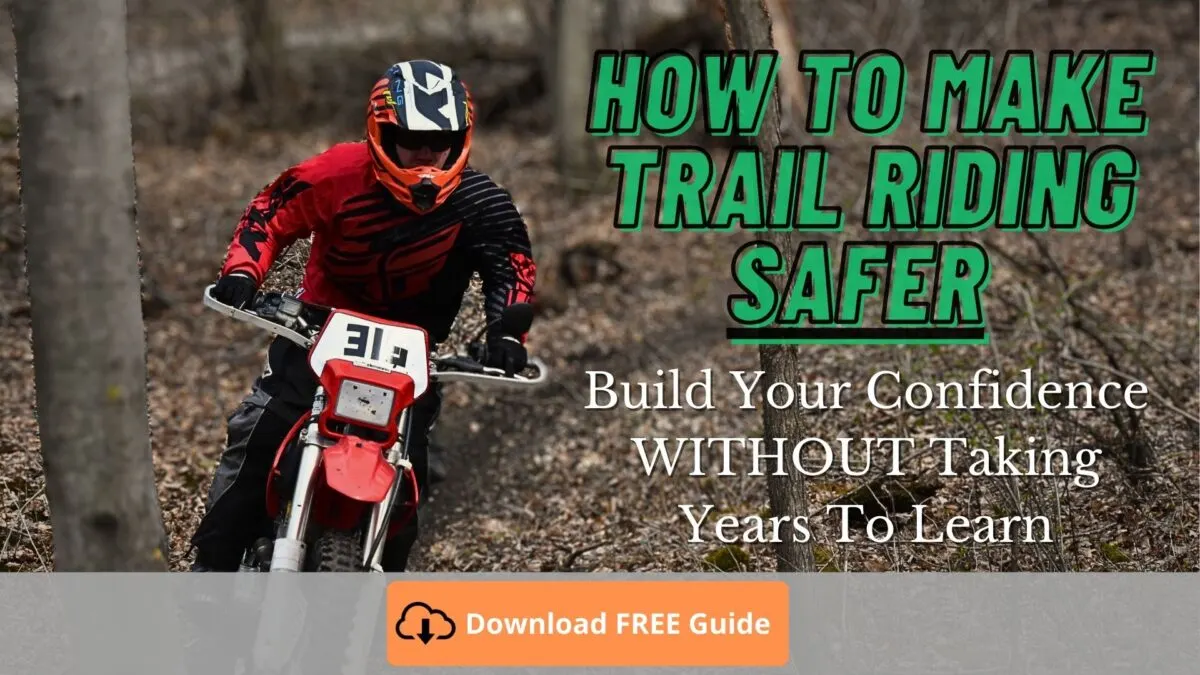Have you ever been trail riding and broken something or got a flat tire? Having tools and parts to repair your dirt bike will save your day of riding.
But you can't carry all of the tools that are in your toolbox with you while riding. I've done numerous dirt bike camping trips and trail rides where it's necessary to bring tools.
![Moose Racing Waist Pack Dirt Bike Tool Kit List For Trail Riding [Survivor's Guide]](https://motocrosshideout.com/wp-content/uploads/2020/09/Moose-Racing-Waist-Pack-960x540.jpg.webp)
This article will cover the contents of my trail pack and fender bag. I only include the top essential items to keep the weight down.
Fanny bag - who cares about looking cool?
Frankly, I'd rather have the best functioning setup, so if I'm on a long trail ride then I'll wear my fanny pack (Amazon) of tools because it's compact and holds my essential tools and spares very well.
I used to put my tools in a backpack where I keep my hydration pack, but that got heavy and exhausting on my back. The fanny pack is less noticeable and tiring around my waist all day.
Front Fender Bag
Spreading the weight out is important in my opinion. If you're wearing a backpack with all of your tools and spare parts all day, your shoulders and back are going to be hurting.
I like my fender bag (Amazon) because it's simple, functional, and durable. I keep my spare inner tube and the 2 tire irons that come with the front fender bag.
How To Prevent Your Fender Bag From Falling Off
Whether you install your fender bag on the front or rear fender, there's always some risk of it coming off if it's not secured.
![Fender Bag Dirt Bike Tool Kit List For Trail Riding [Survivor's Guide]](https://motocrosshideout.com/wp-content/uploads/2020/09/Fender-Bag-960x815.jpg.webp)
I drilled a ¼" hole in the front fender and fender bag inline. I then put an M6 bolt through it with an extra large washer on both sides of it and the nut.
What's In My Fanny Pack?
I used to just use a backpack to hold my tools while trail riding, but that got old fast. On my second big dirt bike camping trip I got a fanny pack to disperse the weight.

The fanny pack works surprisingly well because the weight is hardly noticeable at my waist. I only notice it when I'm standing and bouncing a lot on the trails.
So, what do I put in my fanny pack? Here are its contents:
My Favorite All Around Tool?
I never owned a T-Handle (Amazon) too until a few years ago, which is incredibly hard to believe. After buying one for my portable dirt bike toolbox kit, I started to realize how useful it was and wish I had gotten it years ago.
As soon as I put my trail pack list together I bought another t-handle (Amazon) for it, along with a new set of ¼" sockets for it. I only put the 8, 10, 12, and 13mm in because I rarely use any others.
I did add a socket and screwdriver bits as well so I don't need any full-size screwdrivers in my trail kit for trail riding.
7 Tools in 1??
Instead of bring multiple screwdrivers and Allen wrenches, I really like to throw a multi-tool (Amazon) in my dirt bike tool pack or fanny bag. It's compact, fairly lightweight, and is really useful to have if you need to tighten a carb clamp or make a quick jetting change - trying tightening a screw without a proper bit!
Or if you're a KTM enthusiast, you can get a special KTM trail multi-tool kit (Amazon) that's made for your bike with a few extra tools in a compact design.
What Wrenches Are Best?
Some trail-side dirt bike repairs demand a wrench, such as adjusting the chain or removing the valve stem nut, so I added a select few sizes to my kit - 8, 12, 13, and 15mm are the most popular that I use on my dirt bikes.
Any basic wrenches will work, but lightweight is the name of the game if you're a hardcore single-track trail rider. For that, I'd recommend the motion pro ultralight titanium wrench set (Amazon). They're less than half the weight of steel and they're durable enough for the occasional trail-side usage.
Secondary Wrench
It's smart to have two wrenches of the same size. I don't mean having two full sets, but rather having an adjustable wrench.
Some jobs require a wrench on both sides of the nut and bolt.
To keep the weight down, I got an aluminum adjustable wrench (Amazon). I like mine because it's surprisingly sturdy but super lightweight.
Spark plug wrench
If you don't want an adjustable wrench or want a special tool just for getting your dirt bike's spark plug off and on easily, you can get a Motion Pro Ratchet Spark Plug Wrench (Amazon).
It's fairly lightweight and can be thrown into just about any pack or bag because it's small.
Zip-ties
There's not much to say about this tool other than that zip-ties (Amazon) can come in real handy for certain "patch jobs". They hardly weigh anything, so I always try to keep a handful of them in my pack for trail riding.
Look for cable zip ties that are made for outdoors, such as industrial ties that are UV-resistant or made for high temps to withstand the abuse of riding a dirt bike off-road.
Checking/Filling Tire Pressure
Dirt bike tire pressure is extremely critical. It's something I always try to check before every ride. I like to use my Longacre tire pressure gauge (Amazon) before the ride because I know it's precise.
Not only will this help prevent a flat tire that can ruin your whole day of riding, but you can get more traction and riding comfort by adjusting the PSI in your tires by just 1.
For my actual lightweight trail riding tools, I have a simple pencil tire pressure gauge (Amazon) in my fanny pack to check PSI. It's not quite as accurate, but it gets the job done.
Ways to inflate your tubes/tires
Dirt bike tubes are fairly easy to fill with air, so I use a small bicycle hand air pump (Amazon). It's fairly small and lightweight, so I'd rather have the pump than the CO2 cartridges that run out of air rather quickly.
But if you need high pressure for a tubeless inner tube, then you'll probably need a CO2 cartridge kit (Amazon). They're small, somewhat lightweight, and they fill up tubes fast!
The major downfall is they don't last long and once they're out of charged air, you're done!
Tools To Change Tube
Getting a flat tire on the trail sucks. But what's worse is not having the tools to change it.
The only tools I need to bring for changing a dirt bike tube are 3 tire irons and a spare tube.
I really like my motion pro combo tire irons because they have built-in features to remove the wheel and rim lock. One iron has a 27mm end to remove and install the axle nut (there are multiple options for different model dirt bikes), and then the other tire spoon has a 12mm and 13mm combo to remove the tube and rim lock nuts.
They're super lightweight and don't take up too much room. Since they're short, you'll want 3 tire spoons to make up for the lack of leverage.
Dirt Bike Tool Kit Checklist
I use this same tool kit whether I'm on a KTM enduro bike or a Honda trail bike. The only differences are a couple of tools or spare parts to match each specific dirt bike.
For example, the axle size is different from bike to bike, so I have to make sure that the axle wrench in my tool kit is the right size for the bike I'm riding.
My trail riding tool kit checklist is:
- T-Handle
- 8, 10, 12, 13, 14mm sockets
- Screwdriver bits for socket
- Aluminum adjustable wrench
- Multi-tool
- Locking pliers
- Mini side-cutters
- Zip-ties
- Combo tire irons
- Tire pressure gauge
- Hand air pump
- Quiksteel
- Cash/credit card
- Spare spark plug
- Spare front tube
- Backup CDI
- Hydration pack
- Mini first-aid kit
Here's what I like having in just my fanny-pack:
- T-Handle w/sockets
- Screwdriver bits
- Wrenches (common sizes)
- Adjustable wrench (aluminum)
- Zip-ties
- Tire pressure gauge
- Hand air pump
- Combo tire irons
- Locking pliers
- Mini side-cutters
- Spare spark plug
- Bandages
- Multi-tool
How to be a better & safer trail rider
There are a lot of things that can help improve your riding, but there's only one thing that will make a lifelong difference that you can use on any bike.
It starts with your riding technique, and I want to help you get started the right way. I have a complete guide with practical tips to prepare you for what to expect and what mistakes I made when I started. Click here to be a safer trail rider by learning techniques that give you more control.

